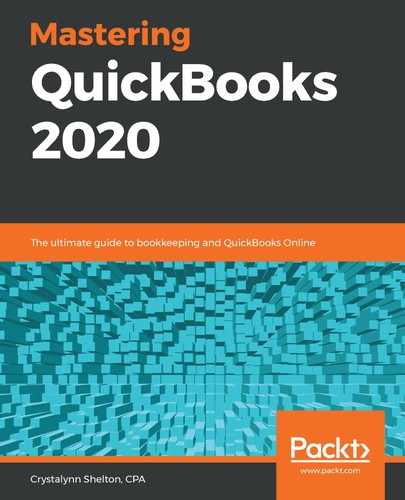If your financial institution does not integrate with QuickBooks, you need to download your credit card transactions to an Excel CSV file. Most banks allow you to download your transactions to a PDF or CSV file. Log into your credit card account and look for the download transactions option. If you don't see this option, contact the credit card company and inform them that you need your transactions in a CSV file so you can download them to QuickBooks.
To upload credit card transactions from an Excel CSV file to QuickBooks, follow these instructions:
- At the beginning of this chapter, we showed you how to add a new account to the chart of accounts list. Follow those step-by-step instructions and add your credit card account to QuickBooks.
- Your credit card account setup screen should resemble the one in the following screenshot:

The following is a brief explanation of the new credit card account fields:
- Account Type (1): The account type will be Credit Card.
- Detail Type (2): This field will automatically be populated with your selection for the account type.
- Name (3): The name of the credit card belongs in this field. If you have multiple credit card accounts at the same financial institution, you may want to consider entering the last four digits of each account in the account name field. This will make it easier when you are entering transactions and reconciling accounts.
- Description (4): You can include a brief description of the account that you are adding in this field or enter the name of the account.
- Balance (5): Enter the current outstanding balance due on your credit card account as of your QuickBooks start date. For example, if you began to use QuickBooks as of January 1, enter the balance owed on your credit card as of the last day of the previous period, which would be December 31 of the previous year.
- as of (6): Enter the date that the balance is effective from. This information should be identical to the date on the credit card statement. If your balance is zero, then there is no need to complete this field.
- From the gear icon, select Import Data located in the Tools column, as shown in the following screenshot:

- The import data screen is where you can import bank and credit card transactions, customers, vendors, a chart of accounts list, and a products and services list. Select the Bank Data option to display the setup screen, as shown in the following screenshot:

- Before uploading your file, you need to save it in a CSV (.csv) format. Click on the Browse button to select the file to upload and the name of the file will appear in the dialog box to the left of the Browse button, as shown in the following screenshot:

- Next, select the credit card account that you want the transactions to upload to in QuickBooks. From the drop-down menu, select the credit card account as indicated in the following screenshot:

- Map the columns in your CSV file to a field in QuickBooks. This is a very important step to ensure that the information is populated in the correct fields in QuickBooks. For each QBO field located on the left, select the column that the data appears in your CSV file, as shown in the following screenshot:

The following is a brief explanation of the new fields that are labeled in the preceding screenshot:
- Date (1): From the dropdown, select the column in the CSV file that includes the date of the credit card transactions. You can also select the format that the date is in (for example, MM/dd/yyyy).
- Description (2): Select the column in the CSV file that includes a description of the transaction.
- Amount (3): From the dropdown, select the column in the CSV file that includes the transaction amount. Amounts can be formatted into one column that includes both positive and negative numbers or into two separate columns, one for positive (credit card charges) and one for negative (credit card payments and credits).
- In this screen, you will see how your data will upload to QuickBooks. It's important to review the data to ensure it is populating the correct fields:

- In this screen, QuickBooks will provide you with the number of transactions to be uploaded. This is your final opportunity to confirm that the data is correct. Once you confirm this, there is no undo button. To proceed with the upload, click the Yes button, as shown in the following screenshot:

After confirming the number of credit card transactions to import, your transactions will be added to QuickBooks. To confirm this, head over to the banking center, where you can see the date, description, and numbers of credit card transactions that were successfully imported from your CSV file.
Now that we know how to connect credit card accounts to QBO, let's see how to provide access to other users in the next section.
